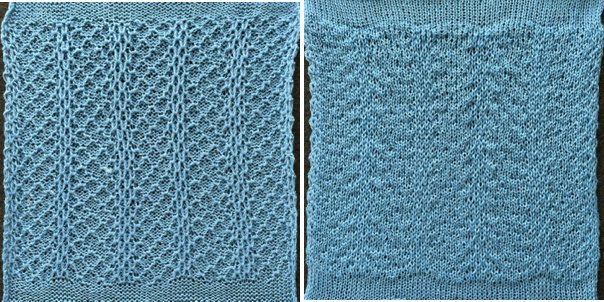This post has been prompted by a recent Ravelry query with respect to having had disappointing results when attempting to knit # 1301 from the Passap Pattern Book as a double-bed fantasy fair isle using a Brother model machine. 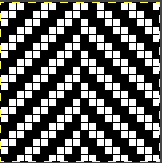
![]() Machine knitters using Japanese model machines are familiar with some tuck rules ie. white pixels/ unpunched squares that form tuck loops, should have a black pixel/ punched hole on each side of them and not occur vertically for more than 4 rows in order for stitches to knit off and form properly.
Machine knitters using Japanese model machines are familiar with some tuck rules ie. white pixels/ unpunched squares that form tuck loops, should have a black pixel/ punched hole on each side of them and not occur vertically for more than 4 rows in order for stitches to knit off and form properly.
Tuck punchcards illustrated in Brother Volume #5 on pp 218 and 219 include a few exceptions to those rules such as #786 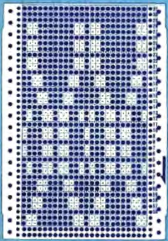 Looking at the reference design in the Passap Pattern book, it is used as a background motif only, not as a tuck one, and rotated using console commands.
Looking at the reference design in the Passap Pattern book, it is used as a background motif only, not as a tuck one, and rotated using console commands. ![]()
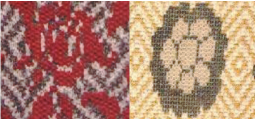 When uncertain as to whether a design repeat is appropriate for a specific stitch type, begin with a limited-size swatch, a thin and familiar yarn, knit slowly, and listen to the sounds the machine produces, which can be early warnings of potential problems.
When uncertain as to whether a design repeat is appropriate for a specific stitch type, begin with a limited-size swatch, a thin and familiar yarn, knit slowly, and listen to the sounds the machine produces, which can be early warnings of potential problems.
The Passap motif issues in terms of tuck knitting analyzed on the first look: there are pairs of blank cells side by side, repeating vertically, and combined throughout  The first test is knit in acetate of unknown thickness, the guess is around 2/18. The 40-stitch swatch measures 6 inches in width, with transitions from and back to stocking stitch horizontal borders, and with the body knit on the single bed with the carriage cams set for tucking in both directions.
The first test is knit in acetate of unknown thickness, the guess is around 2/18. The 40-stitch swatch measures 6 inches in width, with transitions from and back to stocking stitch horizontal borders, and with the body knit on the single bed with the carriage cams set for tucking in both directions. 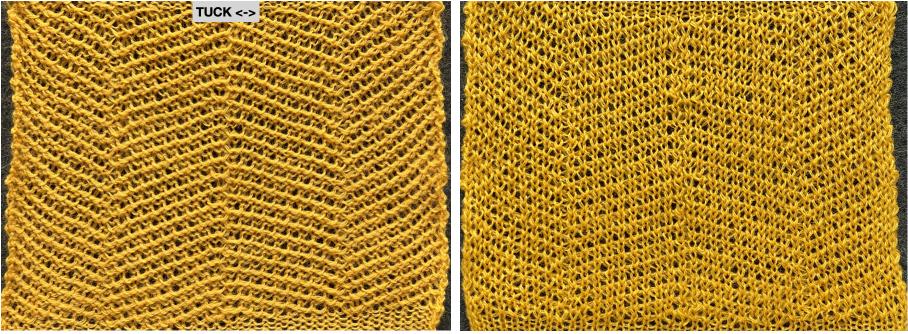 The unaltered repeat may be used double bed, resulting in 8 inches in width, with lots of stretch, and the potential to increase the measurement even more with blocking.
The unaltered repeat may be used double bed, resulting in 8 inches in width, with lots of stretch, and the potential to increase the measurement even more with blocking.
A: transitioning from stocking stitch to every needle rib without added steps will form eyelets
the knit carriage is then set to tuck in both directions, and the ribber carriage is set to knit in both
B: a return to every needle rib before scrapping off 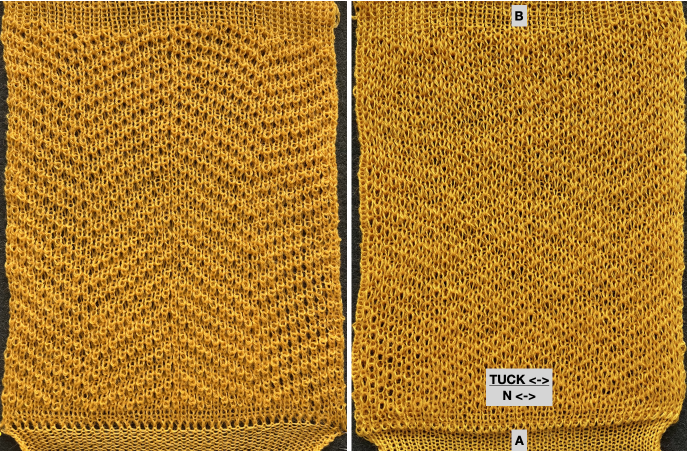 The chart on the left illustrates possible cam variations for knit and ribber beds using tuck settings in Brother machines.
The chart on the left illustrates possible cam variations for knit and ribber beds using tuck settings in Brother machines.
Color separation is required to knit the design using two colors.
In the Passap electronic models, a technique number is entered and the appropriate color separation is performed by the console.
Many results as in this case, rely on each color in each design row being knit twice.
In Brother knitting, other methods need to be used in order to obtain the necessary separation.
The fabric though technically knit as dbj, will begin with the first preselection row from right to left toward the color changer as opposed to from left to right when the built-in electronic KRC separation is used.
Punchcard users can produce the same fabrics if 24 stitch width constraints are met.
The png for the repeat on the right is shared below, and tested using the cam settings 4: 
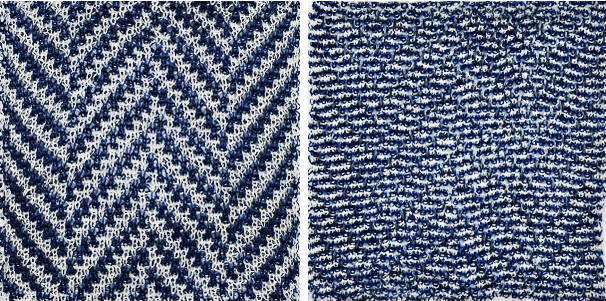 The results using other cam settings can be mixed, and generally far more successful using designs with larger shapes forming design and ground.
The results using other cam settings can be mixed, and generally far more successful using designs with larger shapes forming design and ground.
Using tubular tuck, 2 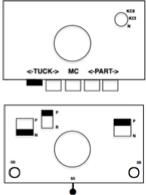 the knit results become muddied, as seen at the top of this test
the knit results become muddied, as seen at the top of this test 
Some previous blog posts exploring motifs worked on the double bed using tuck cam settings on either or both beds:
More shapes on ribber fabrics with tuck patterning, fantasy fair isle
Lace transfers meet fisherman rib, 2 colors, brioche on Brother KM
Lace transfers meet fisherman rib in 2 colors, brioche on Brother KM 1
Geometric shapes on ribber fabrics with tuck stitches 3
Geometric shapes on ribber fabrics with tuck stitches 2; knitting with 4 carriages
Geometric shapes on ribber fabrics with tuck stitches 1
Ribber fabrics with main bed tuck patterning 1/ pick rib
Fisherman and English tuck stitch rib 1_ checks patterns_ Brother, Passap
A different way to bend rules is to use multiple heights of row repeats within a single design, such as in this densely 24X20 tuck stitch design 
![]() Drawn-in-repeat to 120X120 pixels
Drawn-in-repeat to 120X120 pixels 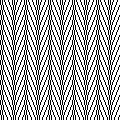 The design would need to be color reversed for use in electronic tuck knitting
The design would need to be color reversed for use in electronic tuck knitting![]() Punchcard users must punch all the black cells
Punchcard users must punch all the black cells 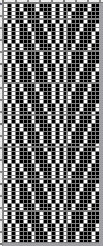 Using thin yarn is best with lots of evenly distributed weight, watch for loops getting hung up on gate pegs
Using thin yarn is best with lots of evenly distributed weight, watch for loops getting hung up on gate pegs 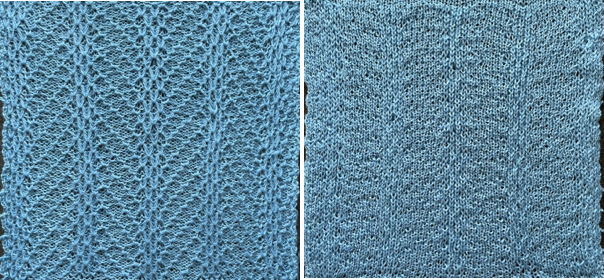 Eliminating one row of blank squares where there are 5 in a row, reduces the repeat to 24X16
Eliminating one row of blank squares where there are 5 in a row, reduces the repeat to 24X16 
![]() The result produces a similar texture. In this test swatch the number of stitches used was planned to attain similar side edges, and end needle selection was canceled
The result produces a similar texture. In this test swatch the number of stitches used was planned to attain similar side edges, and end needle selection was canceled 